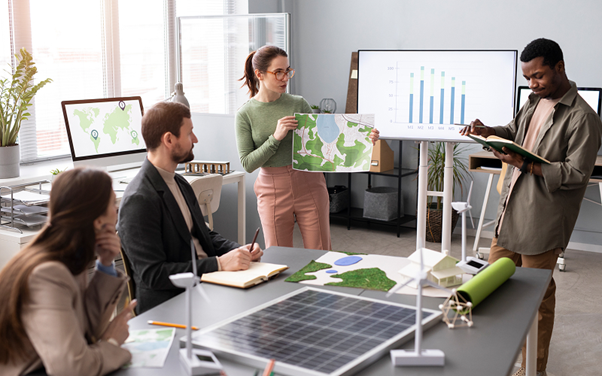Energy efficiency is one of the fundamental goals of sustainable building design, and Environmental Sustainable Design (ESD) consultants play a critical role in ensuring it is met. Whether working on a new development or a retrofit, ESD consultants utilise data-driven and compliance-based solutions to minimise a building’s overall energy use. A building sustainability advisor ensures that systems, materials, and processes are selected and integrated with long-term efficiency and environmental compliance in mind.
Discover four of the most commonly applied strategies ESD consultants use to help buildings operate more efficiently.
1. Passive Design Integration
The first line of defence against excessive energy consumption is passive design. ESD consultants evaluate the site’s solar orientation, wind flow, and surrounding environment to optimise a building’s form, layout, and envelope. The reliance on artificial lighting and mechanical cooling is significantly reduced by positioning spaces to maximise natural daylight and ventilation. This approach may include recommending building materials with high thermal mass, incorporating strategic overhangs or louvres, or adjusting the placement of glazing. Passive design often yields the highest return on investment, as it affects operational energy use without requiring ongoing system inputs. A sustainable building consultant typically collaborates closely with architects during early planning stages to ensure these considerations are structurally feasible and cost-effective.
2. High-Performance HVAC and Zoning Systems
Heating, ventilation, and air-conditioning systems are among the largest contributors to energy demand in commercial buildings. An ESD consultant will assess the current HVAC setup or propose alternatives that meet energy targets while maintaining indoor comfort. One common solution is the implementation of zoned HVAC systems that tailor air delivery based on occupancy and use. Advanced systems also include demand-controlled ventilation, which adjusts airflow depending on CO₂ levels or movement within the space. Consultants may explore hybrid systems or thermal energy storage in larger developments to shift energy loads during off-peak hours. A building sustainability consultant will also ensure that HVAC systems are properly commissioned and integrated with building management systems (BMS) for continuous monitoring and adjustment.
3. Energy-Efficient Lighting and Controls
Lighting accounts for a substantial portion of a building’s energy consumption, especially in commercial and retail environments. ESD consultants design lighting layouts that reduce wattage without compromising illumination levels, often through the use of LED technology and optimised fixture placement. However, the greater impact lies in lighting control systems. Occupancy sensors, daylight sensors, and programmable schedules can automatically adjust lighting based on real-time conditions. These controls are particularly effective in common areas, restrooms, and offices where lighting is frequently left on unnecessarily. A sustainable building consultant may also run a lighting audit as part of an energy modelling report to demonstrate the potential reductions in kilowatt-hours (kWh) over time.
4. Building Performance Simulation and Continuous Commissioning
One of the most technical strategies ESD consultants use is predictive modelling through building simulation software. These digital models allow consultants to forecast a building’s energy consumption under various design and usage scenarios. This method supports evidence-based decision-making during design development and post-construction tuning. In addition to the design phase, many ESD consultants recommend continuous commissioning—an ongoing process that monitors and adjusts systems over time to ensure performance aligns with initial goals. This strategy helps detect system drift, behavioural inefficiencies, or unexpected consumption patterns. A building sustainability consultant may also propose sub-metering for different building zones or systems to generate more granular data for performance reviews.
Conclusion
Reducing a building’s energy consumption is a complex process that requires technical expertise, early involvement, and system-level thinking. Sustainable building consultants provide practical, measurable solutions that assist developers and building owners in meeting both sustainability goals and regulatory expectations by applying passive design principles, improving HVAC systems, utilising smart lighting controls, and relying on simulation data. A sustainable building advisor is not merely a compliance counsel, they are a strategic partner in reducing operational costs and long-term environmental impact.
Contact Afogreen Build today for a consultation tailored to your energy goals and compliance needs.



